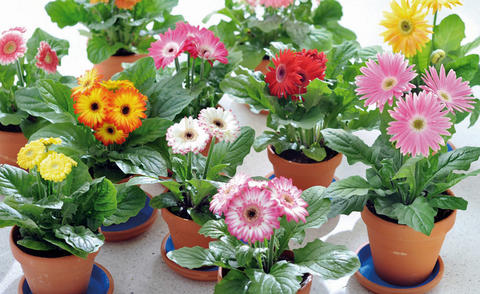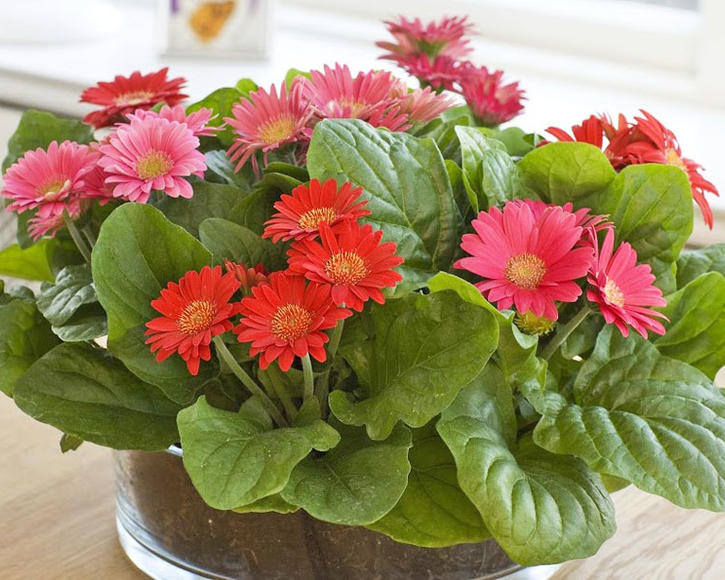Gerbera
With their eye-catching, colorful flower heads, gerberas are quite popular as potted plants and cut flowers. Here you will find tips for planting and care.
Factsheet
- Growth type
-
- Perennial plant
- Growth height (from)
- from 15 cm to 40 cm
- Growth width (from)
- from 20 cm to 30 cm
- Growth characteristics
-
- upright
- rosette-forming
- Flower color
-
- purple
- yellow
- orange
- red
- pink
- white
- Flowering time (month)
-
- May to September
- Flower shape
-
- Uniflorous
- Tongue blossoms
- Leaf color
-
- green
- page format
-
- toothed
- oblong
- obovate
- Light
-
- sunny to scattered light
- Soil type
-
- sandy to loamy
- Soil Moisture
-
- moderately humid
- ph value
-
- neutral
- Lime compatibility
-
- lime-tolerant
- Nutrient requirements
-
- moderately nutritious
- Humus
-
- rich in humus
- Decorative or utility value
-
- Flower Decoration
- Toxicity
-
- weakly poisonous
- Winter Hardness
-
- frost-sensitive
- Use
-
- Interior greening
- Planters
- Garden style
-
- Pot garden
The colorful flowering plant from the sunflower family (Asteraceae) has the same name in Latin and German — Gerbera. The Dutch botanist Jan Frederik Gronovius named the genus of South African ornamental plants, which were initially known as "African asters", in 1737after his German colleague Traugott Gerber. Shortly afterwards, the ornamental plants were added to the botanical nomenclature by Carl von Linné. The colorful gerberas originally come from sunny (South) Africa, Asia and Madagascar. Of the 30 different species, there are some that can be kept as potted plants in the room in this country. Almost all varieties available today that are cultivated for or as houseplants are hybrids.
The colorful gerbera has a compact, steady growth, long flower stalks and deep green, slightly hairy leaves. It develops a rhizome. As the gerbera plants — with the exception of some new varieties such as the Gerbera Garvinea, which can withstand temperatures down to 23 degrees Fahrenheit — are not winter hardy outdoors, they can only be kept outdoors for several years in the Mediterranean climate. Therefore, in our climate, we need keep these plants as cut flowers and as potted plants.
An inflorescence stem rises from each of the leaf axils of the leaves arranged in basal rosettes. The slightly hairy leaves of the gerbera are elongated and obovate to lanceolate, sometimes almost round with wavy or serrated edges. Depending on the variety, the leaves are simple, pinnately lobed or pinnate. The dark green foliage of the gerbera feels parchment-like or leathery.
On each flower stalk there is a single, large cup flower that feels velvety-soft on touching. The variety of colors of the daisy-like flowers ranges from white to yellow, pink and orange to red. Except for blue and purple, all other colors are represented among the gerbera varieties. Two-colored, semi-double and double-flowered cultivars are very attractive.

The gerbera needs a very bright location, preferably full morning or evening sun, at around 68 degrees Fahrenheit. Under no circumstances should the heat-loving plant be exposed to drafts. In summer it is happy to have a warm, sheltered place on the terrace or balcony, where it spreads a tropical flair along with oleander and orange trees. A moderately warm place in the house at a temperature between 59 and 64.4 degrees Fahrenheit works well for overwintering.
A sandy, loose substrate that has good water permeability is ideal for the gerbera. The easiest option is to use potted plant soil mixed with sand.
In general, the gerbera likes to remain moist in the pot, but there should be no waterlogging. Therefore you should water them more in summer than in winter and spray them from time to time to ensure sufficient humidity. Caution: Always water around the plant and not pour water right in the middle, otherwise the gerbera will rot easily. Alternatively, the gerbera can also be immersed in water or watered via plant pot saucer.

During the main flowering period from April to September, the flowering plants need a bit of liquid fertilizer every 14 days. From October the gerbera goes into hibernation and should not be fertilized.
Once the gerbera feels comfortable as a houseplant, it grows vigorous. If it turns out that the plant is deeply rooted in the old pot, it should be repotted in a slightly larger pot in spring after overwintering. A loose, fertile substrate with sand is particularly suitable for this. A Drainage at the base of the pot prevents waterlogging. Tip: For the special effect, choose a planter that highlights the flower color and contrasts with the green of the gerbera leaves.
Gerbera leaves should not be cut, but the flower stalks can occasionally be removed for bouquets. Withered parts of the plant should be regularly removed from potted plants and bedding plants. Gerbera stems are not cut; they are pulled out of the leaf rosette by turning it to the right and pulling it out with one strong pull. Tip: Cut gerberas in the vase last the longest if there is very little water in the vase, which is regularly replaced, as the stems of the gerbera rot easily. Cut the flower stalks in the vase regularly.
If the room air is very dry, you should spray the gerbera leaves with a little water with low level of lime, from time to time; this will also prevent spider mites infestation. It is possible to let the gerbera bloom all year round, but this weakens the plant in the long run and at some point it loses its blooming power. It is therefore advisable to give the gerbera a winter break in a bright but cooler location. Do not fertilize during this time and water very sparingly. In this way, the beautiful flowering plant will be stimulated to bloom again next year.

There are now several hundred varieties of the popular cut flower, most of which were created by crossing Gerbera jamesonii and Gerbera viridifolia, and even other species. Commercially, the gerbera varieties are differentiated according to their size. Mini-gerbera (for example gerbera 'Whisper' in bright pink, 'Terra Chantie' in yellow with black eye or the pure white 'Albin'), also called Germini, have flowers that are 2.36 to 3.14 inches small, while those of the standard gerbera are around 5.11 inches. The giant gerbera hybrids impress with their long stems and brightly colored flowers that measure up to 5.90 inches in size. They are the most popular cut flowers. The double-flowered Gerbera Pomponi ‘Blackpearl’ exhibits a wine-red pompon flower. The wispy , frayed “Orange Spider” has an interesting, wild look.
If you live in a wine-growing climate and want to try planting a gerbera outdoors, you have to go for the moderately hardy Gerbera Garvinea varieties. The varieties of the “Everlast” series can withstand severe weather conditions, such as cold days in spring as well as early cold spells in fall. Caution: Cheap plants available in supermarkets or home improvement stores (DIY stores) are often slow-growing and short-lived. Therefore, it is better to use varieties from specialist shops so that you can enjoy your gerbera for a long time. As a rule, the plants in the pot are available from January.
Propagation of the gerbera is possible in fall or early spring by sowing or in late winter by root division of older plants. To do this, the whole plant is simply lifted out of the pot and cut or plucked in the middle. Caution: Gerbera seeds quickly lose their ability to germinate, so they should not be stored for too long. In summer, the gerbera cuttings can be kept in a glass with a little bit of water to help root formation.
Gerberas are prone to, what is known as, the gerbera-rot, which can be attributed to water-logging or over-fertilization. Here the plant begins to rot and the leaves become unhealthy and usually turn gray-brown or pale green. If the plant is infected with rot, your only option is to discard it. The plant can also get infected by mildew, white flies, thread-footed mites, spider mites and aphids if planted in a wrong location or in case of improper care. If the gerbera does not bloom for a long time, the location is probably too dark.

